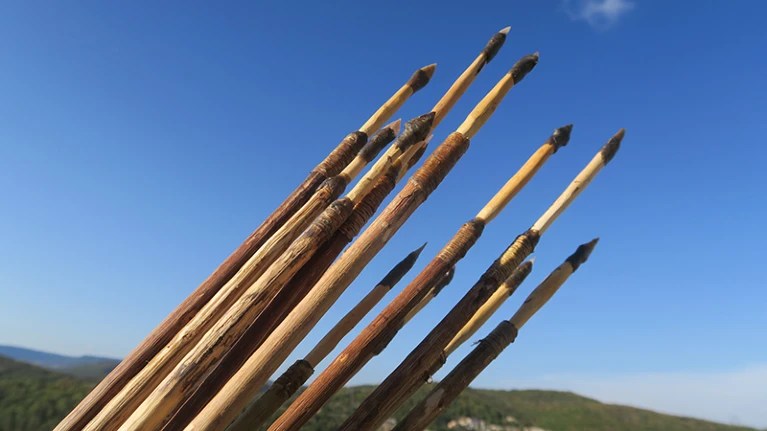Have France’s First Arrows Been Found?

A 54,000-year-old cave site in southern France holds hundreds of tiny stone points, which researchers say closely resemble other known arrowheads — including replicas that they tested on dead goats.
The discovery, reported on 22 February in Science Advances1, suggests that the first Homo sapiens to reach Europe hunted with bows and arrows. But it also raises the question of why Neanderthals — which occupied the Grotte Mandrin rock shelter in the Rhône Valley before and after Homo sapiens — never adopted these superior weapons.
Last year, researchers excavating Grotte Mandrin claimed that the site held the earliest known evidence of Homo sapiens in Europe2. In one of the cave’s archaeological levels, known as layer E, researchers co-led by cultural anthropologist Ludovic Slimak at the University of Toulouse-Jean Jaurès in France identified a child’s tooth and thousands of stone tools. They concluded that the child had been a Homo sapiens.
Among the tools were hundreds of tiny points, many of which were as small as 1 centimetre wide, weighed only a few grams and were nearly identical in shape and size.
The smallest points were similar to other arrowheads made by ancient and modern humans, and some contained similar fractures and other damage at their tips, which could have been created by high-velocity impact.
Spears and arrows
The researchers made dozens of replica points from flint found near the rock shelter, and fashioned them into bows and arrows using wood and other materials. They also made thrusting spears and spear-thrower darts. They used the weapons to stab or shoot at dead goats.
Some of the larger points could have been used effectively with spears or darts. But only a bow and arrow could have generated the force needed to wound or kill an animal with the smallest points, says Laure Metz, an archaeologist at Aix-Marseille University in France who co-led the latest study with Slimak. “It’s not possible to use these tiny points with something other than a bow and arrow.”

Grotte Mandrin contains many horse bones, and Metz suspects that humans sheltering in the cave hunted these animals as well as bison migrating through the Rhône Valley.
The team has found a horse femur with damage consistent with a stone point, and Metz dreams of finding an arrow point embedded in an animal bone.
“This is as solid as it gets,” says John Shea, an archaeologist at Stony Brook University in New York. “They’ve made a more convincing case that these things are arrows, than cases have been made for arrows in data from the last 12,000 years.”
Neanderthal puzzle
Above and below Grotte Mandrin’s layer E, researchers have found Neanderthal teeth and DNA, along with stone tools characteristic of the extinct group.
Slimak’s team contends that layer E represents an early but short-lived incursion of Homo sapiens into Neanderthal territory, more than 10,000 years before the species permanently settled in Europe. Not all archaeologists agree.
If Homo sapiens did make the stone points in layer E, it’s not clear why Neanderthals in the region and elsewhere did not pick up bow-and-arrow technology, as far as anyone can tell. Some researchers have speculated that Neanderthals lacked the cognitive capacity to use projectiles, a difference that might have helped humans to out-compete Neanderthals for scarce game.
But Metz doubts that that is the reason. She wonders whether cultural traditions explain why Neanderthals seem never to have used bows and arrows.
Marie Soressi, an archaeologist at the University of Leiden, the Netherlands, agrees that the Neanderthals living at Grotte Mandrin didn’t leave arrow points behind. But she wonders whether evidence for bow and arrow use might be found elsewhere. “I would find it very strange if Neanderthals were so conservative that they would not copy mechanically propelled weapons used by other humans.”





